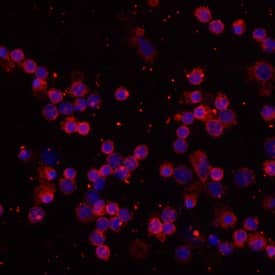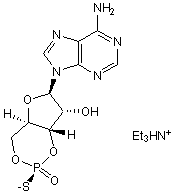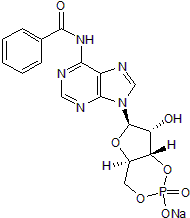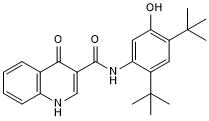cAMP Products
cAMP (adenosine 3’5’-cyclic monophosphate) is a ubiquitous intracellular second messenger that mediates a diverse range of cellular processes in all organisms from bacteria to higher eukaryotes. It is converted from adenosine triphosphate (ATP) by adenylyl cyclases (ACs), and is inactivated by phosphodiesterases (PDEs) which catalyze its hydrolysis to 5’-AMP.
In mammals, upon interaction with extracellular ligands, G protein coupled receptors (GPCRs) linked to Gαs activate the family of nine transmembrane ACs to increase intracellular cAMP. In contrast, GPCRs associated with Gαi/o inhibit the synthesis of cAMP by transmembrane ACs. cAMP binds and activates protein kinase A (PKA), the guanine nucleotide exchange factors Epac1/2, and cyclic nucleotide-gated ion channels. It can be released extracellularly where it is converted to adenosine by phosphodiesterases and nucleotidases.
Products:
12 results for "cAMP" in Products
12 results for "cAMP" in Products
cAMP Products
cAMP (adenosine 3’5’-cyclic monophosphate) is a ubiquitous intracellular second messenger that mediates a diverse range of cellular processes in all organisms from bacteria to higher eukaryotes. It is converted from adenosine triphosphate (ATP) by adenylyl cyclases (ACs), and is inactivated by phosphodiesterases (PDEs) which catalyze its hydrolysis to 5’-AMP.
In mammals, upon interaction with extracellular ligands, G protein coupled receptors (GPCRs) linked to Gαs activate the family of nine transmembrane ACs to increase intracellular cAMP. In contrast, GPCRs associated with Gαi/o inhibit the synthesis of cAMP by transmembrane ACs. cAMP binds and activates protein kinase A (PKA), the guanine nucleotide exchange factors Epac1/2, and cyclic nucleotide-gated ion channels. It can be released extracellularly where it is converted to adenosine by phosphodiesterases and nucleotidases.
Products:
| Sensitivity: | 8.57 pmol/mL |
| Applications: | ELISA |
| Assay Range: | 3.75 - 240 pmol/mL (Cell Culture Supernates, Cell Lysates, Serum, EDTA Plasma, Heparin Plasma, Saliva, Urine) |
| Sensitivity: | 1.54 nmol/L |
| Applications: | ELISA |
| Assay Range: | 3.75 - 240 nmol/L (Cell Culture Supernates, Cell Lysates, Tissue Homogenates, EDTA Plasma, Urine) |
Cell-permeable cAMP analog
| Chemical Name: | N6,O2'-Dibutyryl adenosine 3',5'-cyclic monophosphate sodium salt |
| Purity: | ≥98% (HPLC) |
Cell-permeable cAMP analog
| Chemical Name: | 8-Bromoadenosine-3',5'-cyclic monophosphate sodium salt |
| Purity: | ≥99% (HPLC) |
| Reactivity: | Multi-Species |
| Details: | Mouse IgG1 Monoclonal Clone #250532 |
| Applications: | ICC |
cAMP antagonist
| Chemical Name: | (R)-Adenosine, cyclic 3',5'-(hydrogenphosphorothioate) triethylammonium |
| Purity: | ≥98% (HPLC) |
Cell-permeable cAMP analog
| Chemical Name: | (S)-Adenosine, cyclic 3',5'-(hydrogenphosphorothioate) triethylammonium |
| Purity: | ≥98% (HPLC) |
Cell permeable cAMP analog
| Chemical Name: | N-Benzoyladenosine cyclic 3',5'-(hydrogen phosphate) monosodium salt |
| Purity: | ≥98% (HPLC) |
For use with catalog numbers KGE002B, SKGE002B, PKGE002B
| Applications: | Ctrl |
For use with catalog number KGE012
| Applications: | Ctrl |
Recombinant Monoclonal Antibody
| Reactivity: | Non-species specific |
| Details: | Rabbit IgG Monoclonal Clone #RM466 |
| Applications: | ELISA |
Potent and selective CFTR potentiator
| Chemical Name: | N-[2,4-Bis(1,1-dimethylethyl)-5-hydroxyphenyl]-1,4-dihydro-4-oxo-3-quinolinecarboxamide |
| Purity: | ≥98% (HPLC) |











![ELISA: cAMP Antibody (RM466)[NBP3-18822] cAMP Antibody (RM466)](https://resources.bio-techne.com/images/products/nbp3-18822_rabbit-camp-mab-rm466-16112023130187.png)
